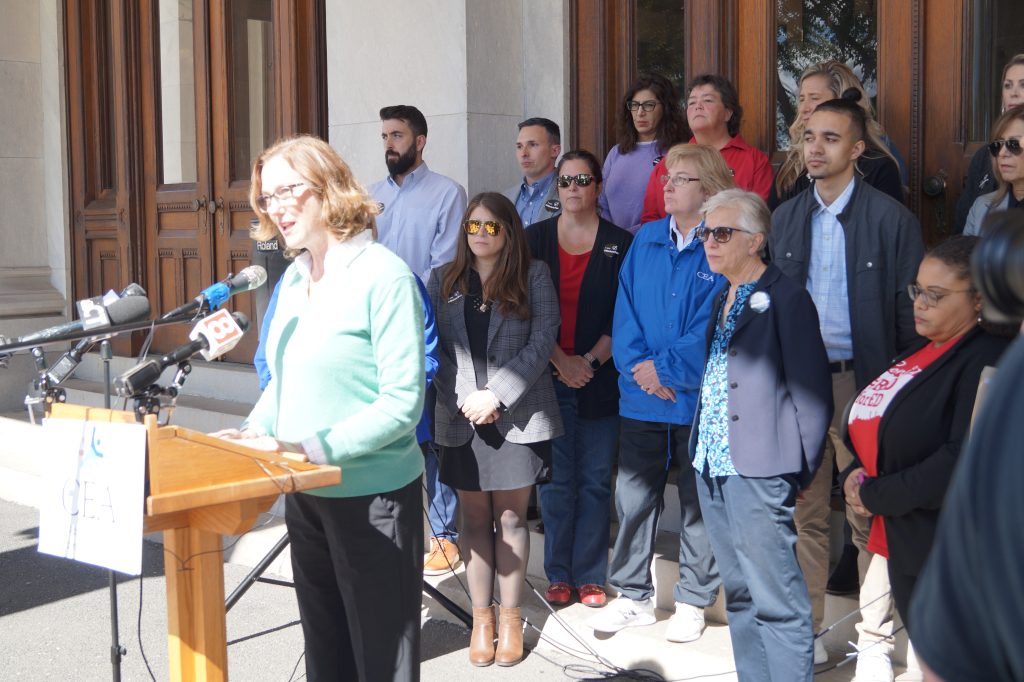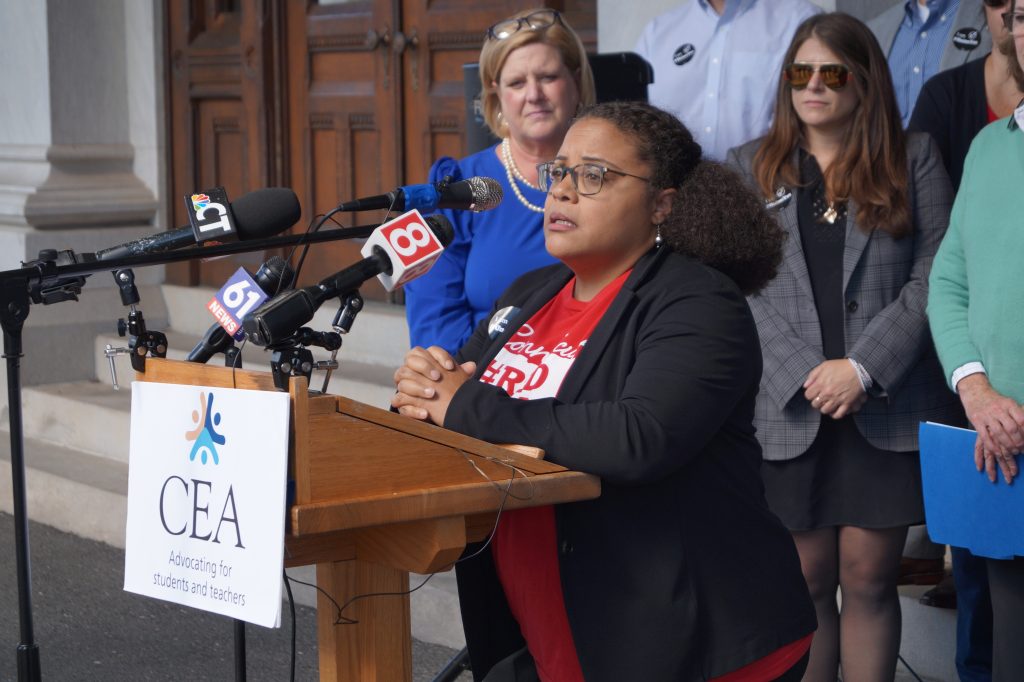Despite a law passed last legislative session that prohibits dual instruction, the State Department of Education (SDE) yesterday issued guidelines that undermine legislators’ intent and allow districts to move forward using the dual instruction model that studies have proven is detrimental to students.
“This attempt to codify and create a narrative where dual instruction is allowed is puzzling, given that dual instruction was banned last legislative session,” CEA President Kate Dias told reporters today at a CEA and AFT Connecticut news conference denouncing the new SDE guidelines. Read the CEA news release.
“Legislators expect when they pass a law, and I know this first hand, that our administrative departments carry out the wishes of those legislators who listen to their constituents, who gather the facts, and take action,” said CEA Executive Director Donald Williams, a former president of the State Senate. “Every now and then, and this is a prime example, an administrative department turns its back on what the legislature did and what constituents wanted.”
As a Manchester math teacher working during the pandemic, Dias had firsthand experience with dual instruction that divided her attention between her in-person students and those logging in virtually, watering down the learning experience for both groups.
“Adopting dual instruction practices is really throwing in the towel on best practices. It’s saying, ‘Some kids get the best, some kids don’t,'” Dias said.’

Norwalk Federation of Teachers President Mary Yordon said that students who most need an instructional model with proven effectiveness would be the most likely to be exposed to dual instruction under the SDE’s guidance.
She explained that remote learning has its place and teachers aren’t opposed to intentional remote learning or creative instructional practices, but expecting teachers to effectively instruct students in the classroom and on the computer at the same time is expecting the impossible.
Norwalk Federation of Teachers President Mary Yordon said that dual teaching was an unfortunate experiment that arose out of the emergency situation that existed early in the pandemic. “In real life, in real time, during the excruciating early years of this pandemic, we learned that dual teaching was a failed experiment that we should no longer engage in. If we are to overcome the learning crisis faced by far too many students in far too many Connecticut school districts there are better choices and more effective models.”
She continued, “The new guidelines allow dual teaching models to be implemented across the state as a result of learning differences through a PPT or a 504 process, for illness, and for inter- and intra-district collaboration. The very students who would benefit the most from an instructional model with proven effectiveness are now allowed to be exposed to the model featuring the poorest learning environment.”
All of the educators who spoke today objected to the idea that dual instruction could in any way enhance equity in our schools or reduce racial isolation for students in underserved communities, as stated in the SDE guidelines.

Westport teacher Faith Sweeney said, “Just because students of diverse backgrounds are remotely coming into a classroom it doesn’t mean that they’re building relationships with their teacher or with other students from other communities.”
Westport teacher Faith Sweeney said she could envision wealthy suburban districts using dual instruction as a loophole to avoid real integration in their schools by having students from urban districts join classes remotely instead of in-person.
“Just because students of diverse backgrounds are remotely coming into a classroom it doesn’t mean that they’re building relationships with their teacher or with other students from other communities,” she said. “Connecticut has to do better. Connecticut has to think about fully funding programs that will provide better opportunity, access, and increase diversity.”
“Only a year ago the State Department of Education issued their assessment report finding that, during the pandemic, the greatest learning loss was suffered by those students in hybrid remote formats. The best, obviously, was in-person, in the classroom,” said Williams. “So, SDE’s own evidence shows that this dual teaching model is deficient, inferior. It is second class education for students in the greatest need.”

Teachers Heidi Florian, CEA Vice President Joslyn DeLancey, CREC Education Association President Lisa Cordova, Norwalk Federation of Teachers President Mary Yordon, CEA President Kate Dias, Faith Sweeney, and Hartford Federation of Teachers President Carol Gale spoke in opposition to the SDE’s new guidance on dual instruction at today’s press conference.
“We are already facing a teacher shortage,” said Hartford Federation of Teachers President Carol Gale. “One of the reasons we have a teacher shortage is that teachers across the nation are feeling overwhelmed and underappreciated, and that is very true for Hartford and many of our districts here in Connecticut. So if you want to get rid of more teachers, ask them to do more and ask them to do instruction that we know as educators does not work.”
Dias said that Bridgeport and New London are cited as models for best practices when it comes to dual instruction in the SDE guidance, yet, when she reached out to both districts, neither had any knowledge of the programs referenced.
“Not all of this guidance is based on reality, and that is problematic. We will continue to strongly object to what is set forward as bad practice and harmful to the children in the state of the Connecticut.”
She continued, “Those of us who are practicing and in the classroom have a very different perspective than those who are administering. And I think that’s really what some of the divide is based on. Those of us who have practiced this and lived with the consequence of dual instruction have very strong feelings about its negative impact on children. I think people who haven’t actually had to do it think it’s not a big deal, and I think that there in lies a great divide. And I think honestly, it’s time to listen to the teachers. We know what we’re talking about.”







